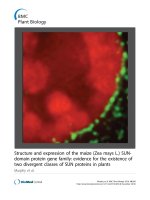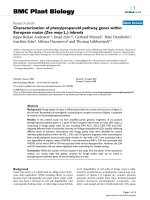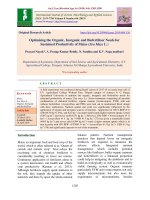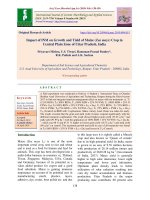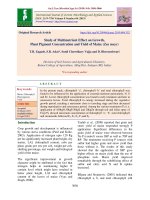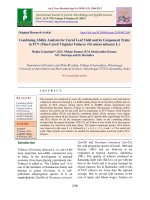Combining ability analysis of morpho-physiological traitsin maize (Zea mays L.) inbred lines
Bạn đang xem bản rút gọn của tài liệu. Xem và tải ngay bản đầy đủ của tài liệu tại đây (159.86 KB, 7 trang )
Int.J.Curr.Microbiol.App.Sci (2017) 6(4): 470-476
International Journal of Current Microbiology and Applied Sciences
ISSN: 2319-7706 Volume 6 Number 4 (2017) pp. 470-476
Journal homepage:
Original Research Article
/>
Combining Ability Analysis of Morpho-Physiological
Traitsin Maize (Zea mays L.) inbred lines
Padma Lay* and A.K. Razdan
Division of Genetics and plant breeding, Sher-e-Kashmir University of Agricultural Sciences
and Technology (SKUAST-J), Chatha, Jammu
*Corresponding author
ABSTRACT
Keywords
Maize (Zea mays
L.), sca/gca, Gene
action, Hybrids,
Yield.
Article Info
Accepted:
02 March 2017
Available Online:
10 April 2017
Combining ability analysis for yield and its component traits was performed with
8lines, 3 testers and the resulting 24 crosses using Line×Tester analysis. The
analysis of variance indicated significant differences among parents, lines, testers,
crosses, and parents vs. crosses for almost all the traits. The ratio of sca/gca
variance revealed that there was preponderance of non additive gene action in the
expression of all the traits. Inbred lines viz., JML-109, CML-161, JML 112 and
V25 were good general combiners for yield and yield attributing characters, Tester
VQL1 was high combiner for grain yield. Among the hybrids, CML-161 X CM
212, JML-109 X VQL1 and JM-112 X V341exhibited highest significant sca
effects for yield and yield attributing traits.
Introduction
Maize is an extensively investigated crop for
heterosis breeding and occupies the pride
place in launching the first hybrid breeding
programme in the country under auspicious of
all India Co-ordinated Maize Improvement
Project. Maize acreage and production have
an increasing tendency with the introduction
of hybrids due to its high yield potential. The
nature and magnitude of gene action is an
important factor in developing an effective
breeding programme. Combining ability
analysis is useful to assess the potential inbred
lines and also helps in identifying the nature
of gene action involved in various
quantitative characters. This information is
helpful to plant breeders for formulating
hybrid breeding programmes. A wide array of
biometrical tools is available to breeders for
characterizing
genetic
control
of
economically important traits as a guide to
decide upon an appropriate breeding
methodology to involve in hybrid breeding.
The present investigation was carried out to
determine breeding value of genotypes, nature
and magnitude of gene action for various
yield and other important traits in maize (Zea
mays L.). Line×tester mating design
developed by Kempthorne (1957), which
provides reliable information on the general
and specific combining ability effects of
parents and their hybrid combinations was
used to generate the information. The design
has been widely used in maize by several
workers and continues to be applied in
470
Int.J.Curr.Microbiol.App.Sci (2017) 6(4): 470-476
quantitative genetic studies in maize (Joshi et
al., 2002; Sharma et al., 2004).
predominance of non-additive gene action for
grain yield. Similar study confirms the
findings of the workers (Divan et al., 2013;
Kamara et al., 2014; Kanagrasu et al., 2010;
Musa abadi et al., 2011). The analysis of
variance for combining ability revealed that
mean squares due to lines, testers and
line×testers were significant for all the
characters except days to 75% brown husk,
ear placement height and test weight (Table
1). General combining ability effects for grain
yield per plant, parents V358, JML-109,
CML-161 and V341, JML-112 for Days to
50% pollen shed, CML-161 for days to 50%
silking, V358 for width, JML-109 and CML161 for ear length and ear girth JML-109,
V25 and VQL1 for kernel per row were found
to be good combiners this is in accordance
with the studies of Divan et al., (2013) and
Shah et al., (2015) days to 75% brown husk,
LTP-1.
Materials and Methods
Eight lines and three testers were mated in
aline×tester design during kharif2013. The
resulting 24 F1s and their parents were grown
in a Randomized Complete Block Design
with two replications at farm of division of
Plant Breeding and Genetics, SKUAST-J,
chatha maintaining spacing between rows 60
cm and between plants25 cm and one plant
per hill. Observations were recorded on
twelve yield and yield attributing traits viz.,
days to 50 per cent pollen shed, days to 50 per
cent silking, days to 75 per cent brown husk
plant height (cm), ear placement height (cm),
Leaf width (cm), ear length (cm), ear girth
(cm), Kernel rows per year, Kernels per row
Test weight (g) and Grain yield plant-1 (g).
The data were subjected for analysis of
variance for all the characters studied as per
the method suggested by Panse and Sukhatme
(1961). The variance of combining ability was
estimated as per the procedure developed by
Kempthorne (1957). The mean squares for
GCA and SCA were tested against desired
error variance.
Therefore, the parent V358 showed
significant GCA effects for grain yield per
plant and days to75% brown husk; the parent
JML-109 showed significant GCA effects for
grain yield per plant, ear length and kernels
per row; parent CML-161 showed significant
GCA effects for grain yield per plant and ear
girth; parent V358 showed significant GCA
effects for grain yield per plant, days to 50%
silking, days to 75% brown husk; parent V
341 showed significant GCA effects for Grain
yield per plant and kernel rows per year
(Table 2).
Results and Discussion
Analysis of variance for line x tester revealed
significant differences for line for all the
characters, mean squares due to testers were
significant in characters grain yield and ear
girth. Variance components due to line x
tester interaction showed significant in
characters viz., ear placement height and leaf
width (where variance due to lines was more).
It has been generally reported that in
relatively selected material non-additive gene
action was more important than additive gene
action (Sprague and Tatum, 1942 and
Hayman, 1957). The experimental material
generated from the crosses revealed the
Among twelve characters studied all
manifested higher degree of sca variance as
compared to gca variance. The higher sca
variance revealed the predominance of non
additive genetic variance. Contrarily,
importance of additive gene effects was
reported by Alamnie et al., (2006). The per
cent contribution of line x tester interaction
appeared high to the bulk of the variation
observed in hybrids.
471
Int.J.Curr.Microbiol.App.Sci (2017) 6(4): 470-476
Table.1 Mean sum of squares in lines x testers design for 12 morpho-physiological traits in maize (Zea mays L.)
Source of
variation
Replication
Treatment
Parents
Parents
(lines)
Parents
(tester)
Parents
(L vs T)
Parents vs.
crosses
Crosses
Error
Days to
Days to
50%
50%
Pollen
Silking
Shed
Days to
75%
Brown
Husk
Plant
Height (cm)
Ear
Placement
Height
(cm)
Leaf
Width
(cm)
Ear
Length
(cm)
Ear
Girth
(cm)
Kernel
Rows
per
Ear
Kernels
per
Row
Test
Weight
(gm)
d.f
Grain
Yield
(gm)
2
34
10
7.35
483.68**
231.69**
1.81
5.38*
5.03
6.62
4.67*
5.11
16.58
12.42**
8.84
11.67
3549.83**
132.79*
12.36
930.50**
55.19
0.02
0.46**
0.40**
0.95
5.97**
5.79*
0.14
1.04**
1.23*
0.13
1.34**
0.28
13.53
41.68**
15.09
252.23
455.16*
301.30
7
159.63**
5.10
5.33
7.52
173.39*
18.39
0.30*
6.06*
1.00
0.211
14.61
294.81
2
589.82**
4.44
5.10
9.16
55.98
8.191
0.15
7.62
2.24*
0.64
13.44
474.67
1
19.89
5.77
3.67
17.37
2.14
406.78**
1.61**
0.22
0.84
0.02
21.70
0.065
1
7421.16** 81.97** 42.96** 175.97** 110376.17** 28027.30** 7.25** 79.47** 7.36** 16.82** 496.01** 5058.14**
23
68
291.61**
31.24
2.20
2.88
2.82
2.75
6.86
6.07
390.88**
64.65
132.96**
44.33
472
0.19
0.13
2.85
2.48
0.68
0.52
1.13**
0.36
33.49**
8.89
321.93
235.38
Int.J.Curr.Microbiol.App.Sci (2017) 6(4): 470-476
Table.2 Estimates of General combining ability effects of lines and testers for different characters in maize (Zea mays L.)
Source
Line
JML-109
CML-161
V25
HKI-161
JML-120
LTP-1
JML-112
V358
S.E.gi(line)
S.E.gi-gj(line)
Tester
V341
CM212
VQL1
S.E.gi(tester)
S.E.gi-gj(tester)
Grain
Yield
(gm)
Days to
50%
Pollen
Shed
Days to
50%
Silking
Days to
75%
Brown
Husk
Plant
Height
(cm)
Ear
Placement
Height
(cm)
Leaf
Width
(cm)
Ear
Length
cm
Ear
Girth
cm
Kernel
Rows
per Ear
Kernels
per Row
Test
Weight
(gm)
7.49**
5.38**
-10.54**
-0.55
-9.39**
-4.85*
0.01
12.47**
1.89
2.67
-0.35
-0.42
0.53
1.04
-0.14
0.25
-1.31*
0.40
0.57
0.80
-0.04
-1.18*
0.90
0.84
0.46
-0.21
-0.20
-0.57
0.56
0.79
-0.58
0.29
0.51
0.96
-0.47
0.44
0.73
-1.87*
0.82
1.16
-3.11
5.59
-0.57
3.57
-3.03
15.61**
-4.19
-13.86**
2.68
3.79
-1.17
0.21
-1.33
3.54
-1.94
6.42**
1.01
-6.74**
2.22
3.13
0.02
-0.06
0.18
-0.04
-0.07
0.11
-0.14
0.00
0.12
0.17
1.41*
-0.02
0.72
-0.59
-0.48
-0.73
-0.67
0.37
0.52
0.74
0.39
0.64*
0.26
-0.11
-0.40
-0.36
-0.44
0.01
0.24
0.34
0.40
0.16
-0.12
-0.17
-0.43*
0.35
-0.45*
0.26
0.20
0.29
2.85**
-3.27**
2.63*
1.38
-0.42
-1.25
-2.40*
0.48
0.99
1.40
3.74
-2.08
-0.49
0.97
-9.48
1.18
-0.36
6.52
5.11
7.23
2.83*
-1.03
-1.80
1.15
1.63
0.02
-0.04
0.02
0.35
0.49
-0.50
0.47
0.04
0.34
0.48
-0.09
0.54
-0.45
0.50
0.71
1.97
1.68
-3.65*
1.64
2.32
-0.30
1.90
-1.60
1.36
1.92
-0.16*
0.00
0.16*
0.08
0.10
-0.11
0.13
-0.01
0.32
0.46
0.05
0.13
-0.18
0.15
0.20
0.31*
0.00
-0.30*
0.12
0.18
-0.97
-0.55
1.51*
0.61
0.86
5.93
-5.76
-0.17
3.13
4.42
*, ** significant at 5% and 1% level, respectively
473
Int.J.Curr.Microbiol.App.Sci (2017) 6(4): 470-476
Table.3 Estimates of Specific combining ability effects of crosses for different traits of (3x8) line x tester analysis
Crosses
Grain
Yield
(gm)
Days to
50%
Pollen
Shed
JML-109 xV341
JML-109 xCM212
JML-109 X VQL1
CML-161x V341
CML-161x CM212
CML-161X VQL1
V25xV341
V25xCM212
V25 x VQL1
HKI-161xV341
HKI-161xCM212
HKI-161x VQL1
JML-120 xV341
JML-120 xCM212
JML-120 xVQL1
LTP-1 xV341
LTP-1 xCM212
LTP-1 xVQL1
JML-112xV341
JML-112xCM212
JML-112 X VQL 1
V358xV341
V358xCM212
V 358xVQL 1
S.E.(sij)
S.E.sij-skl
-0.98
-9.15**
10.12**
-10.03**
13.13**
-3.10
-0.48
-1.35
1.82
6.53
-5.07
-1.47
-1.50
2.50
-1.00
0.77
-0.17
-0.60
9.91**
-4.84
-5.06
-4.22
4.94
-0.72
3.26
4.60
0.52
-1.32
0.79
-0.23
-0.47
0.70
0.24
0.01
-0.25
0.13
0.60
-0.73
-0.06
0.64
-0.58
-0.21
0.12
0.09
0.09
-0.18
0.09
-0.49
0.61
-0.12
0.98
1.38
Days
Days
Ear
to 75
Plant
Leaf
Ear
Ear
to
placement
%
Height
Width Length Girth
50%
Height
Brown
(cm)
(cm)
(cm)
(cm)
Silking
(cm)
Husk
-0.21
-0.32 -10.32*
-9.22*
-0.25
0.18
0.20
-0.24
0.28
16.96**
11.62**
-0.25
-1.25
-0.21
0.45
0.04
-6.64
-2.40
0.50*
1.06
0.01
-0.31
2.84
1.05
-0.81
0.16
0.24
-0.08
-0.04
0.64
-6.60
-1.63
0.05
-0.26
-0.10
0.35
-3.47*
5.56
2.43
-0.21
0.02
0.18
-1.35
-0.05
11.63*
5.33
-0.14
0.12
-0.53
0.41
-0.15
-9.08
-7.07
-0.14
-0.55
0.08
0.94
0.20
-2.55
1.74
0.28
0.43
0.45
0.10
-0.60
7.67
7.43
-0.08
-0.61
-0.31
-0.37
-0.50
-8.72
-7.98*
0.12
0.26
0.33
0.26
1.09
1.05
0.55
-0.03
0.35
-0.02
0.76
-0.03
6.40
1.40
-0.10
-0.13
0.03
-0.44
0.10
1.85
2.07
0.09
0.04
-0.08
-0.32
-0.07
-8.25
-3.47
0.00
0.10
0.05
0.80
-1.54
-1.44
0.69
0.08
-0.42
0.09
-0.11
-0.07
-5.53
-4.61
-0.08
0.28
-0.01
-0.69
1.62
6.97
3.92
0.00
0.14
-0.08
0.62
-0.60 -10.74*
-8.13*
0.14
-0.12
0.16
0.01
0.77
5.91
8.57*
0.11
1.39
0.27
-0.63
-0.17
4.84
-0.44
-0.24
-1.26
-0.43
-0.42
0.30
-4.24
3.32
0.20
0.74
0.45
0.78
-1.06
5.21
-0.98
0.10
0.11
-0.28
-0.36
0.76
-0.96
-2.33
-0.30
-0.84
-0.16
0.96
1.42
4.64
3.84
0.20
0.91
0.42
1.35
2.01
6.57
5.44
0.29
1.29
0.59
*, ** significant at 5% and 1% level, respectively
474
Kernel
Rows
per
Ear
Kernels
per
Row
Test
Weight
(gm)
0.48
0.77*
-1.25**
-0.52
-0.20
0.72*
-0.33
-0.28
0.61
-0.36
0.28
0.08
-0.06
0.22
-0.16
0.26
-0.58
0.32
0.25
-0.11
-0.14
0.29
-0.11
-0.18
0.35
0.49
-4.01*
1.91
2.09
1.96
0.19
-2.15
2.55
0.21
-2.76
-1.95
1.96
-0.01
-2.46
-0.99
3.45
-0.13
-3.48*
3.61*
0.49
0.83
-1.32
3.53*
-0.64
-2.90
1.72
2.43
-2.99
1.72
1.27
3.83
-6.35
2.52
13.44
-6.68
-6.76
-0.05
-11.23
11.28
11.66
-0.42
-11.24
-8.83
4.39
4.44
-5.89
1.99
3.90
-11.17
16.58
-5.41
8.86
12.53
Int.J.Curr.Microbiol.App.Sci (2017) 6(4): 470-476
High yield cross combination CML-161 X
CM 212 showed significant SCA effects for
grain yield per plant, days to 50% pollen shed
and days to 50% silking; the cross JML-109
X VQL1 showed significant SCA effects for
grain yield per plant and leaf width; the cross
JM -112 X V341 showed significant SCA
effects for grain yield per plant. Good specific
combiners (Table 3) were exhibited by
crosses viz., CML-161 X CM 212, JML-109
X VQL1 and JML-112 X V341 for grain
yield; CML-161 X VQL1 for days to 75%
brown husk; JML-109 X CM 212 and V25 X
V341 for plant height; JML-109 X CM 212
and JML-112 X CM 212 for ear placement
height; LTP-1 X VQL1 and V358 X V341for
Kernels per row. Therefore crosses viz.,
CML-161 X CM 212, JML-109 X VQL1 and
JM-112 X V341 involved at least one parent
as good general combiner indicated the
superiority due to non additive gene action.
These results are in agreement with Alamnie
et al., (2003), Kamara et al., (2014), Mahesh
et al., (2013) and Chandel and Mankotia
(2014). Prasad and Pramod Kumar (2003),
Subramaniyan and Subbraman (2006),
Jayakumar
and
Sundram
(2007),
Vijayabharathi et al., (2009) reported that
specific combining ability (SCA) variances
were higher than general combining ability
variances (GCA) for all the characters which
indicated preponderance of non-additive gene
action for all the characters.
Sci., 16(1): 131-133.
Alamnie, A., Wali, M.C., Salimath, P.M. and
Jagadeesha, R.C. 2006.Combining
ability and heterosis for grain yield and
ear characters in maize. Karnataka J.
Agri. Sci., 19: 13-16.
Chandel, U. and Mankotia, B.S. 2014.
Combining ability in local and
CIMMYT inbred lines of maize (Zea
mays L.) for grain yield and yield
components using line × tester analysis.
Sabrao J. Breeding and Genetics, 46(2):
256-264.
Divan, R., Khorasani, S.K., Ebrahimi, A. and
Bakhtiari, S. 2013. Study on Combining
Ability and Gene Effects in inbred lines
and single Cross hybrids of Forage
maize (Zea mays L.). Int. J. Agron.
Plant Production, 4(6): 1290-1297.
Jayakumar, J. and Sundaram, T. 2007.
Combining ability studies for grain
yield and other yield components in
maize (Zea mays L.), Crop Res.,
(Hisar), 33(1-3): 179-186.
Joshi, A.B. and Dhawan, N.L. 1966. Genetic
improvement of yield with special
reference to self-fertilizing crops.
Indian J. Genetics, 26: 101-113.
Kamara, M.M., El-Degwy, I.S. and Koyama,
H. 2014. Estimation combining ability
of some maize inbred lines using line ×
tester mating design under two nitrogen
levels. Australian J. Crop Sci., 8(9):
1336-1342.
Kanagarasu, S., Nallathambi, G. and Ganesan,
K.N. 2010. Combining ability analysis
for yield and its component traits in
maize (Zea mays L.). Electronic J.
Plant Breeding, 1(4): 915-920.
Kempthorne, O. 1957. An Introduction to
Genetics Statistics, 1st eds, pp. 457-71.
John wiley and sons, New York.
Mahesh, N., Wali, M.C., Gowda, M.V.C.,
Motagi, B.N. and Uppinal, N.F. 2013.
Genetic analysis of grain yield, starch,
protein and oil content in single cross
Acknowledgements
The authors are thankful to the AICRP maize
centre Udampur for supplying seed material
to conduct this research.
References
Alamnie, A., Nayakar, N.Y. and Wali, M.C.
2003 Combining Ability, Heterosis and
per se Performance of Height
Characters in Maize. Karnataka J. Agri.
475
Int.J.Curr.Microbiol.App.Sci (2017) 6(4): 470-476
hybrids of maize. Karnataka J. Agri.
Sci., 26(2): 185-189.
Musa-Abadi, J., Khavari-Khorasani, S., SyahSar, B., Movafeg, S. and Golbashi, M.
2011. Estimation of combining ability
and gene effects in forage maize (Zea
mays L.) using Line × Tester Crosses. J.
Plant Physiol. Breeding, 1(1): 57-67.
Panse, V.G. and Sukhatme, P.V. 1961.
Statistical methods for agricultural
research workers, New Delhi: ICAR.
Prasad, S.K., and Kumar P., 2003, Line×tester
analysis for combining ability in maize,
J. Res., (RAU), 13: 68-72.
Shah, L., Rahman, H.U., Ali, A., Bazai, N.A.
and Tahir, M. 2015.Combining ability
estimates from line x tester mating
design in maize (Zea mays L.).
Academic Res. J. Agri. Sci. Res., 3(4):
71-75.
Subramaniyan, A., and Subbraman, N. 2006.
Combining ability analysis for yield and
its contributing traits in maize, Indian J.
Agri. Res., 40: 131-134.
Vijayabharathi, A., Anandakumar, C.R., and
Gnanamalar, R.P. 2009. Combining
ability analysis for yield and its
components in popcorn (Zea mays var.
everta Sturt.). Electronic J. Plant
Breeding, 1: 28-32.
Westman, A.L. and Kresovich, S. 1997. Use
of molecular marker techniques for
description of plant genetic variation.
In: Callow, J. L., Ford-Lloyd, B. V. and
Newburry, H. J. (eds.). Biotechnol.
Plant Genetic Res., CAB Int., pp. 9-45
How to cite this article:
Padma Lay and Razdan, A.K. 2017. Combining Ability Analysis of Morpho-Physiological
Traitsin Maize (Zea mays L.) inbred lines. Int.J.Curr.Microbiol.App.Sci. 6(4): 470-476.
doi: />
476
